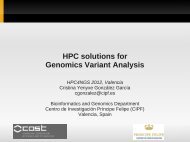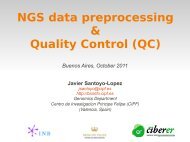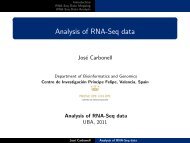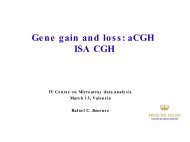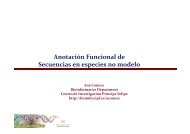Qualimap user manual (pdf)
Qualimap user manual (pdf)
Qualimap user manual (pdf)
You also want an ePaper? Increase the reach of your titles
YUMPU automatically turns print PDFs into web optimized ePapers that Google loves.
CONTENTS1 Introduction 11.1 What is <strong>Qualimap</strong>? . . . . . . . . . . . . . . . . . . . . . . . . . . . . . . . . . . . . . . . . . . 11.2 Installation . . . . . . . . . . . . . . . . . . . . . . . . . . . . . . . . . . . . . . . . . . . . . . 11.3 Requirements . . . . . . . . . . . . . . . . . . . . . . . . . . . . . . . . . . . . . . . . . . . . . 11.4 Installing <strong>Qualimap</strong> on Ubuntu . . . . . . . . . . . . . . . . . . . . . . . . . . . . . . . . . . . 21.5 Citing <strong>Qualimap</strong> . . . . . . . . . . . . . . . . . . . . . . . . . . . . . . . . . . . . . . . . . . . 32 Workflow 52.1 Starting a new analysis . . . . . . . . . . . . . . . . . . . . . . . . . . . . . . . . . . . . . . . . 52.2 Viewing the results of the analysis . . . . . . . . . . . . . . . . . . . . . . . . . . . . . . . . . . 62.3 Exporting results . . . . . . . . . . . . . . . . . . . . . . . . . . . . . . . . . . . . . . . . . . . 72.4 Using tools . . . . . . . . . . . . . . . . . . . . . . . . . . . . . . . . . . . . . . . . . . . . . . 73 Analysis types 93.1 BAM QC . . . . . . . . . . . . . . . . . . . . . . . . . . . . . . . . . . . . . . . . . . . . . . . 93.2 Counts QC . . . . . . . . . . . . . . . . . . . . . . . . . . . . . . . . . . . . . . . . . . . . . . 114 Tools 154.1 Compute counts . . . . . . . . . . . . . . . . . . . . . . . . . . . . . . . . . . . . . . . . . . . 154.2 Clustering . . . . . . . . . . . . . . . . . . . . . . . . . . . . . . . . . . . . . . . . . . . . . . 175 Command Line Interface 195.1 General Description . . . . . . . . . . . . . . . . . . . . . . . . . . . . . . . . . . . . . . . . . 195.2 BAM QC . . . . . . . . . . . . . . . . . . . . . . . . . . . . . . . . . . . . . . . . . . . . . . . 195.3 Counts QC . . . . . . . . . . . . . . . . . . . . . . . . . . . . . . . . . . . . . . . . . . . . . . 205.4 Clustering . . . . . . . . . . . . . . . . . . . . . . . . . . . . . . . . . . . . . . . . . . . . . . 205.5 Compute counts . . . . . . . . . . . . . . . . . . . . . . . . . . . . . . . . . . . . . . . . . . . 216 Examples 236.1 Sample Data . . . . . . . . . . . . . . . . . . . . . . . . . . . . . . . . . . . . . . . . . . . . . 236.2 Sample Output . . . . . . . . . . . . . . . . . . . . . . . . . . . . . . . . . . . . . . . . . . . . 237 Frequently Asked Questions 257.1 General . . . . . . . . . . . . . . . . . . . . . . . . . . . . . . . . . . . . . . . . . . . . . . . . 257.2 Performance . . . . . . . . . . . . . . . . . . . . . . . . . . . . . . . . . . . . . . . . . . . . . 25Bibliography 27i
<strong>Qualimap</strong> Documentation, Release 0.5The JAVA runtime can be downloaded from the official web-site. There are prebuilt binaries available for manyplatforms.R enviroment can be downloaded from R project web-site.Note: In general the installation of R environment is platform-specific and may require additional efforts.Several <strong>Qualimap</strong> features are implemented in R, using a number of external packages.Note: If R environment is not available or required R-packages are missing, “Counts QC” and “Clustering”features will be disabled.Currently <strong>Qualimap</strong> requires the following R-packages:• optparse (available from CRAN)• Repitools, Rsamtools, GenomicFeatures, rtracklayer (available from Bioconductor)One can install these packages <strong>manual</strong>ly or by executing the script found in the installation folder:Rscript scripts/installDependencies.r1.4 Installing <strong>Qualimap</strong> on UbuntuThis <strong>manual</strong> is specific for Ubuntu(Debian) Linux distribution, however with slight differences this can be appliedfor other GNU Linux systems.1.4.1 Install JAVAIt is possible to use openjdk:sudo apt-get install openjdk-6-jre1.4.2 Install RThe R latest version can be installed from public repos.The repos must be added to the sources file. Open sources.list:sudo gedit /etc/apt/sources.listAdd the following line:deb http:///bin/linux/ubuntu /List of cran mirrors can be found hereHere is an example for Ubuntu 10.04 (Lucid):deb http://cran.stat.ucla.edu/bin/linux/ubuntu lucid/Then install R:sudo apt-get updatesudo apt-get install r-base-coreIf you don’t have the public key for the mirror add it:gpg --keyserver subkeys.pgp.net --recv-key gpg -a --export | sudo apt-key add -More details available here:2 Chapter 1. Introduction
<strong>Qualimap</strong> Documentation, Release 0.54 Chapter 1. Introduction
CHAPTERTWOWORKFLOW2.1 Starting a new analysis• To start new analysis activate main menu item File → New Analysis and select the desired type of analysis.Read more about different types of analysis here.• After the corresponding item is selected a dialog will appear that allows customizing analysis options (inputfiles, algorithm parameters, etc.).5
<strong>Qualimap</strong> Documentation, Release 0.5• To run the analysis click the Start analysis button.• During the computation a status message and a graphic bar will indicate the progress of the computation.2.2 Viewing the results of the analysis• After the selected analysis is finished the results are shown as an interactive report in the <strong>Qualimap</strong> mainwindow. Several reports can be opened at the same time in different tabs.6 Chapter 2. Workflow
<strong>Qualimap</strong> Documentation, Release 0.5• In the left part of the report window one can find a list containing available result items. Clicking on an itemwill automatically show the corresponding information report or graph. Some report items are common fordifferent types of analysis.• For example, the Summary section provides a short summary of performed quality control checks, while theInput section lists all the input parameters. Further information about each specific result is provided here.2.3 Exporting results• The resulting report along with raw statistics data can be saved to HTML page or PDF document.• To export results to HTML use a main menu item File → Export to HTML. In the dialog window one canselect the output folder. After clicking OK button the web-page, containing analysis results along with rawstatistics data will be saved to the specified directory.• Similarly one can save the report to a PDF document by using a main menu item File → Export to PDF.• Note that for plots in BAM QC and Counts QC it is also possible to export the underlying raw data using thecontext menu, with appears by clicking the right mouse button in the corresponding plot. In addition, whenthe report is exported to HTML, the raw data for all plots can be found in the output folder.2.4 Using tools• <strong>Qualimap</strong> is desgined to provide NGS-related tools that can be used aside from the quality control analysis.Currently two tools are available (more are planned to be added in the future):1. Compute Counts for counting how many reads are mapped to each region of interest at the desiredlevel (genes, transcripts, etc.)2. Clustering for obtaining groups of genomic features that share similar coverage profiles2.3. Exporting results 7
<strong>Qualimap</strong> Documentation, Release 0.58 Chapter 2. Workflow
CHAPTERTHREEANALYSIS TYPES3.1 BAM QCBAM QC reports information for the evaluation of the quality of the provided alignment data (a BAM file). Inshort, the basic statistics of the alignment (number of reads, coverage, GC-content, etc.) are summarized and anumber of useful graphs are produced. This analysis can be performed with any kind of sequencing data, e.g.whole-genome sequencing, exome sequencing, RNA-seq, ChIP-seq, etc.In addition, it is possible to provide an annotation file so the results are computed for the reads mapping inside(and optionally outside) of the corresponding genomic regions, which can be especially useful for evaluatingtarget-enrichment sequencing studies.To start a new BAM QC analysis activate main menu item File → New Analysis → BAM QC.3.1.1 Examples• Whole-genome sequencing: HG00096.chrom20.bam. Report for sample alignment file from 1000 Genomesproject.• Whole-genome sequencing: ERRR089819.bam. Report created using the whole-genome sequencing dataof Caenorhabditis elegans from the following study.• See the Sample data section for more details about the data used in the examples.3.1.2 Input ParametersBAM file Path to the sequence alignment file in BAM format. Note, that the BAM file has to be sorted bychromosomal coordinates. Sorting can be performed with samtools sort.Analyze regions Activating this option allows the analysis of the alignment data for the regions of interest.Regions file(GFF/BED file) The path to the annotation file that defines the regions of interest. The file must betab-separated and have GFF/GTF or BED format.Library strand specificityThe sequencing protocol strand specificity: non-strand-specific, forward-stranded or reversestranded.This information is required to calculate the number of correct strand reads.Analyze outside regions If checked, the information about the reads that are mapped outside of the regions ofinterest will be also computed and shown in a separate section.Chromosome limits If selected, vertical dotted lines will be placed at the beginning of each chromosome accordingto the information found in the header of the BAM file.Compare GC content distribution with This allows to compare the GC distribution of the sample with the selectedpre-calculated genome GC distribution. Currently two genome distributions are available: human(hg19) and mouse (mm9). More species will be included in future releases.9
<strong>Qualimap</strong> Documentation, Release 0.5Advanced parametersNumber of windows Number of windows used to split the reference genome. This value is used for computingthe graphs that plot information across the reference. Basically, reads falling in the same window areaggregated in the same bin. The higher the number, the bigger the resolution of the plots but also longertime will be used to process the data. By default 400 windows are used.Number of threads In order to speed up the computation, the BAM QC analysis computation can be performedin parallel on a multicore system using the given number of threads. More information on the parallelizationof qualimap can be found in FAQ. The default number of threads equals number of available processors.Size of the chunk In order to reduce the load of I/O, reads are analyzed in chunks. Each chunk contains theselected number of reads which will be loaded into memory and analyzed by a single thread. Smallernumbers may result in lower performance, but also the memory consumption will be reduced. The defaultvalue is 1000 reads.3.1.3 OutputSummaryInputBasic information and statistics for the alignment data. <strong>Qualimap</strong> reports here information aboutthe total number of reads, number of mapped reads, paired-end mapping performance, read lengthdistribution, insert size, nucleotide content, coverage, number of indels, mapping quaility andchromosome-based statistics.For region-based analysis the information is given inside of regions, including some additional informationlike, for example, number of correct strand reads.Here one can check the input data and the parameters used for the analysis.Coverage Across ReferenceThis plot consists of two figures. The upper figure provides the coverage distribution (red line) andcoverage deviation across the reference sequence. The coverage is measured in X 1 . The lower figureshows GC content across reference (black line) together with its average value (red dotted line).Coverage HistogramHistogram of the number of genomic locations having a given coverage rate. The bins of the x-axisare conveniently scaled by aggregating some coverage values in order to produce a representativehistogram also in presence of the usual NGS peaks of coverage.Coverage Histogram (0-50X)Histogram of the number of genomic locations having a given coverage rate. In this graph genomelocations with a coverage greater than 50X are grouped into the last bin. By doing so a higherresolution of the most common values for the coverage rate is obtained.Genome Fraction by CoverageProvides a visual way of knowing how much reference has been sequenced with at least a givencoverage rate. This graph should be interpreted as in this example:If one aims a coverage rate of at least 25X (x-axis), how much of reference (y-axis) will be considered?The answer to this question in the case of the whole-genome sequencing provided example is~83%.Mapped Reads Nucleotide ContentThis plot shows the nucleotide content per position of the mapped reads.Mapped Reads Clipping Profile1 Example for the meaning of X: If one genomic region has a coverage of 10X, it means that, on average, 10 different reads are mapped toeach nucleotide of the region.10 Chapter 3. Analysis types
<strong>Qualimap</strong> Documentation, Release 0.5Represents the percentage of clipped bases across the reads. The clipping is detected via SAM formatCIGAR codes ‘H’ (hard clipping) and ‘S’ (soft clipping). In addition, the total number of clippedreads can be found in the report Summary. The plot is not shown if there are no clipped-reads arefound. Total number of clipped reads can be found in Summary. Example.Mapped Reads GC Content DistributionThis graph shows the distribution of GC content per mapped read. If compared with a precomputedgenome distribution, this plot allows to check if there is a shift in the GC content.Homopolymer IndelsThis bar plot shows separately the number of indels that are within a homopolymer of A’s, C’s,G’s or T’s together with the number of indels that are not within a homopolymer. Large numbersof homopolymer indels may indicate a problem in a sequencing process. An indel is consideredhomopolymeric if it is found within a homopolymer (defined as at least 5 equal consecutive bases).Owing to the fact that <strong>Qualimap</strong> works directly from BAM files (and not from reference genomes),we make use of the CIGAR code from the corresponding read for this task. Indel statistics cam befound in a dedicated section of the report Summary.This chart is not shown if the sample doesn’t contain any indels.Duplication Rate HistogramThis plot shows the distribution of duplicated read starts. Due to several factors (e.g. amountof starting material, sample preparation, etc) it is possible that the same fragments are sequencedseveral times. For some experiments where enrichment is used (e.g. ChIP-seq ) this is expected atsome low rate. If most of the reads share the exact same genomic positions there is very likely anassociated bias.Mapping Quality Across ReferenceThis plot provides the mapping quality distribution across the reference.Mapping Quality HistogramHistogram of the number of genomic locations having a given mapping quality. According toSpecification of the SAM format the range for the mapping quality is [0-255].3.2 Counts QCIn RNA-seq experiments, the reads are usually first mapped to a reference genome. It is assumed that if thenumber of reads mapping to a certain biological feature of interest (gene, transcript, exon, ...) is sufficient, it canbe used as an estimation of the abundance of that feature in the sample and interpreted as the quantification ofthe expression level of the corresponding region.These count data can be utilized for example to assess differential expression between two or more experimentalconditions. Before assesing differential expression analysis, researchers should be aware of some potential limitationsof RNA-seq data, as for example: Has the saturation been reached or more features could be detectedby increasing the sequencing depth? Which type of features are being detected in the experiment? How goodis the quantification of expression in the sample? All of these questions are answered by interpreting the plotsgenerated by <strong>Qualimap</strong>.For assesing this analysis just activate from the main menu File → New Analysis → Counts QC.Note: If count data need to be generated, one can use the provided tool Compute counts.Note: For this option to work, the R language must be installed along with the R package optparse (both arefreely available from http://cran.r-project.org/).3.2. Counts QC 11
<strong>Qualimap</strong> Documentation, Release 0.53.2.1 Example• RNA-seq count data. This report was produced using the counts from the RNA-seq of Homo sapiens kidneyand liver samples [Marioni].• These counts can be downloaded from here or generated using the Compute counts tool.3.2.2 Input ParametersFirst sample (counts)File containing the count data from the sample. This must be a two-column tab-delimited text file,with the feature IDs in the first column and the number of counts in the second column. This file mustnot contain header nor column names. See Counts for examplesFirst sample nameName for the first sample that will be used as legend in the plots.Second sample (counts)Optional. If a second sample is available, this file should contain the same information as in Firstsample for the second sample, i.e. the same feature IDs (first column) and the corresponding numberof counts (second column). Mark the Compare with other sample checkbox to enable this option.Second sample nameName for the second sample that will be used as legend in the plots.Count thresholdGroup FileSpeciesIn order to remove the influence of spurious reads, a feature is considered as detected if its correspondingnumber of counts is greater than this threshold. By default, the theshold value is set to 5counts, meaning that features having less than 5 counts will not be taken into account.Optional. File containing a classification of the features of the count files. It must be a two columnstab-delimited text file, with the features names or IDs in the first column and the group (e.g. thebiotype from Ensembl database) in the second column (see human.64.genes.biotypes for an example).Again, the file must not contain any header or column names. If this file is provided, specific plots foreach defined group are generated. Please, make sure that the features IDs on this file are the same inthe count files.Optional. For convinience, <strong>Qualimap</strong> provides the Ensembl biotype classification 2 for certainspecies (currently Human and Mouse). In order to use these annotations, Ensembl Gene IDs shouldbe used as the feature IDs on the count files (e.g. ENSG00000251282). If so, mark the box to enablethis option and select the corresponding species. More annotations and species will be made availablein future releases.3.2.3 OutputGlobal PlotsGlobal SaturationThis plot provides information about the level of saturation in the sample, so it helps the <strong>user</strong> to decideif more sequencing is needed or if no many more features will detected when increasing the numberof reads. These are some tips for the interpretation of the plot:2 Downloaded from Biomart v.61.12 Chapter 3. Analysis types
<strong>Qualimap</strong> Documentation, Release 0.5• The increasing sequencing depth of the sample is represented at the x-axis. The maximum valueis the real sequencing depth of the sample(s). Smaller sequencing depths correspond to samplesrandomly generated from the original sample(s).• The curves are associated to the left y-axis. They represent the number of detected features ateach of the sequencing depths in the x-axis. By “detected features” we refer to features withmore than k counts, where k is the Count threshold selected by the <strong>user</strong>.• The bars are associated to the right y-axis. They represent the number of newly detected featureswhen increasing the sequencing depth in one million reads at each sequencing depth value.An example for this plot can be seen here.When a Group File is provided by the <strong>user</strong> or chosen from those supplied by <strong>Qualimap</strong>, a series ofplots are additionally generated:Samples CorrelationWhen two samples are provided, this plot determines the correlation level between both samples.Due to the often wide range of expression data (counts), a log2-transformation is applied in order toimprove the graphical representation. Features not detected in any of the two samples are removedfor this analysis. To avoid infinite values in the case of genes with 0 counts in one of the samples,log2(expression + 1) is used. Thus, sample 1 is depicted in X-axis and sample 2 in Y-axis. The colorsof the plot should be interpreted as a map. The blue color is the level of the sea and the white colorthe top of the mountain. Hence, the higher you are over the sea level, the more genes you have in thatrange of X-Y values. In addition, the title of the plot includes the Pearson’s correlation coefficient,which indicates if both samples present a linear relationship.Detection Per ClassThis barplot allows the <strong>user</strong> to know which kind of features are being detected his sample(s). Thex-axis shows all the groups included in the Group File (or the biotypes supplied by <strong>Qualimap</strong>). Thegrey bars are the percentage of features of each group within the reference genome (or transcriptome,etc.). The striped color bars are the percentages of features of each group detected in the sample withregard to the genome. The solid color bars are the percentages that each group represents in the totaldetected features in the sample.Counts Per ClassA boxplot per each group describes the counts distribution for the detected features in that group.Individual Group PlotsSaturation per groupFor each group, a saturation plot is generated like the one described in Global Saturation.Counts & Sequencing DepthFor each group, a plot is generated containing a boxplot with the distribution of counts at each sequencingdepth. The x-axis shows the increasing sequencing depths of randomly generated samplesfrom the original one till the true sequencing depth is reached. This plot allows the <strong>user</strong> to see howthe increase of sequencing depth is changing the expression level quantification.3.2. Counts QC 13
<strong>Qualimap</strong> Documentation, Release 0.514 Chapter 3. Analysis types
CHAPTERFOURTOOLS4.1 Compute counts• Given a BAM file and an annotation (GTF file), this tool calculates how many reads are mapped to eachregion of interest.• The <strong>user</strong> can decide:– At which level wants to perform the counting (genes, transcripts...).– What to do whith reads mapped to multiple locations.– The strand-specifity.– When a transcriptome GTF file is provided the tool allows to calculate 5’ and 3’ prime coverage bias.To access the tool use Tools → Compute counts.Note: For paired-end reads currently each mate of a pair is considered independently (taking into account thestrand-specificity of the protocol). We will add full support for paired-end reads in future versions of <strong>Qualimap</strong>.4.1.1 Example• Input data:• Output:– BAM file: liver.bam. RNA-seq of liver tissue from Marioni JC et al– GTF file: human.64.gtf . Human annotation from Ensembl (v. 64)– Parameters:* Feature ID: gene_id (to count at the level of genes)* Feature type: exon (to ignore other features like start/end codons)* Multimapped reads: uniquely-mapped-reads (to ignore not unique alignments)– liver.counts. Two-column tab-delimited text file, with the feature IDs in the first column and thenumber of counts in the second column.4.1.2 InputBAM file Path to the BAM alignment file.Annotation file Path to the GTF or BED file containing regions of interest.Protocol15
<strong>Qualimap</strong> Documentation, Release 0.5Controls when to consider reads and features to be overlapping:non-strand-specific Reads overlap features if they share genomic regions regardless of the strand.forward-stranded For single-end reads, the read and the feature must have the same strand to beoverlapping. For paired-end reads, the first read of the pair must be mapped to the same strandas the feature, while the second read must be mapped to the opposite strand.reverse-strand For single-end reads, the read and the feature must have the opposite strand. Forpaired-end reads, the first read of pair must be mapped to the opposite strand of the feature,while the second read of the pair must be on the same strand as the feature.Feature ID The <strong>user</strong> can select the attribute of the GTF file to be used as the feature ID. Regions with the sameID will be aggregated as part of the same feature. The application preload the first 1000 lines of the file soa list with possible feature IDs is conveniently provided.Feature type The <strong>user</strong> can select the feature type (value of the third column of the GTF) considered for counting.Other types will be ignored. The application preload the first 1000 lines of the file so a list with possiblefeature IDs is conveniently provided.Output Path to the ouput file.Save computation summary This option controls whether to save overall computation statistics. If selected, thestatistics will be saved in a file named $INPUT_BAM.countsMulti-mapped reads This option controls what to do whith reads mapped to multiple location:uniquely-mapped-reads Reads mapped to multiple locations will be ignored.proportional Each read is weighted according to the number of mapped locations. For example, a readmapped to 4 different locations will add 0.25 to the counts of each location.Calculate 5’ and 3’ coverage bias If a GTF file is provided, the <strong>user</strong> has the possibility of computing 5’ - 3’ bias.The application automatically constructs the 5’ and 3’ UTR (100 bp) from the gene definitions of the GTFfile and determines the coverage rate of the 1000 most highly expressed transcripts in the UTR regions.This information is then stored in the computation summary file, together with the statistics of the countingprocedure.Note: This option requires a standard gene model definition. The UTRs are computed for the first and last exonsof each transcript. Therefore, exon is the feature of interest (third field of the GTF) and gene_id, transcript_idshould be attributes (ninth field of the GTF).4.1.3 OutputA two-column tab-delimited text file, with the feature IDs in the first column and the number of counts in thesecond column, and overall calculation stats.The calculation stats include:Feature counts Number of reads assigned to various featuresNo feature Number of reads not aligned to any featureNot unique alignment Number of reads with non-unique alignmentAmbiguous Number of reads that align to features ambigouslyThe following stats are calculate only if option Calulate 5’ and 3’ bias was set:Median 5’ bias For 1000 most expressed genes the ratio between coverage of 100 leftmost bases andmean coverage is calcualted and median value is provided.Median 3’ bias For 1000 most expressed gene the ratio between coverage of 100 rightmost bases andmean coverage is calculated and median value is provided.16 Chapter 4. Tools
<strong>Qualimap</strong> Documentation, Release 0.5Median 5’ to 3 For 1000 most expressed genes the ratio between coverag of 100 leftmost and 100rightmost bases is calculated and median value is provided.4.2 Clustering• <strong>Qualimap</strong> provides the possibility of clustering genomic features according to their surrounding coverageprofiles. This is particulary interesting in epigenomic studies (e.g. methylation). The <strong>user</strong> can import a setof features (e.g. TSSs or CpG Islands) together with the BAM file. Then the application preprocess the dataand clusters the profiles using the Repitools package (Statham et al). The obtained groups of features aredisplayed as a heatmap or as line graphs and can be exported for further analysis (e.g. for measuring thecorrelation between promoter methylation and gene expression).• Summary of the process:– filter out the non-uniquely-mapped reads– compute the smoothed coverages values of the samples at the desired locations– apply k-means on the smoothed coverage values for the desired values of k• To perform this analysis the <strong>user</strong> needs to provide at least two BAM files – one for the sample (enriched)and other for the control (input) – and a list of features as BED file.• Clustering analysis can be accesed using the menu item File → Tools → Clustering.Note: Clustering coverage profiles is not a straightforward task and it may be necessary to perform a numberof empirical filter steps. In order to correctly interpret the approach the results we encourage the <strong>user</strong>s to readRepitools User Manual.4.2.1 Input ParametersExperiment ID The experiment nameAlignment data Here you can provide your replicates to analyze. Each replicate includes sample file and a controlfile. For example, in an epigenomics experiment, the sample file could be the MeDIP-seq data and thecontrol the non-enriched data (the so-called INPUT data). Thus, for each replicate the following informationhas to be provided:Replicate name Name of the replicateSample file Path to sample BAM fileControl file Path to control BAM fileTo add a replicate click Add button. To remove a replicate select it and click Remove button. You can modifyreplicate by using Edit button.Regions of interest Path to an annotation file in BED or GFF format, which contains regions of interest.Location Relative location to analyzeLeft offset Offset in bp upstream the selected regionsRight offset Offset in bp downstream the selected regionsBin size Can be thought as the resolution of the plot. Bins of the desired size will be computed and the informationfalling on each bin will be aggregatedNumber of clusters Number of groups that you the <strong>user</strong> wants to divide the data. Several values can be used byseparating them with commasFragment length Length of the fragments that were initially sequenced. All reads will be enlarged to this length.Visualization type You can visualize cluster using heatmaps or line-based graphs.4.2. Clustering 17
<strong>Qualimap</strong> Documentation, Release 0.54.2.2 OutputAfter the analysis is performed, the regions of interest are clustered in groups based on the coverage pattern. Theoutput graph shows the coverage pattern for each cluster either as a heatmap or a line graph. There can be multiplegraphs based on the number of clusters provided as input. The name of each graph consists of the experimentname and the number of clusters.It is possible to export list of features beloning to the particular cluster. To do this use main menu item File →Export gene list or context menu item Export gene list. After activating the item a dialog will appear where youcan choose some specific cluster. One can either copy the list of features belonging to this cluster in the clipboardor export it to a text file.18 Chapter 4. Tools
CHAPTERFIVECOMMAND LINE INTERFACE5.1 General DescriptionEach analysis type presented in QualiMap GUI is also available as command line tool. The common pattern tolaunch the tool is the following:qualimap is the name of the desired analysis. This could be: bamqc, countsqc, clustering or counts. are specific to each type analysis. If not option is provided for the specific tool a full list ofavailable options will be shownTo show available tools use command:qualimap --help5.2 BAM QCThe following command allows to perform BAM QC analysis:usage: qualimap bamqc -bam [-c] [-gd ] [-gff ] [-nr ] [-nt] [-nw ] [-os] [-outdir ] [-outformat ]-bam input mapping file-c,--paint-chromosome-limits paint chromosome limits inside charts-gd compare with genome distribution (possiblevalues: HUMAN or MOUSE)-gff region file (in GFF/GTF or BED format)-nr number of reads in the chunk (default is 500)-nt number of threads (default equals the number of cores)-nw number of windows (default is 400)-os,--outside-statscompute region outside stats (only with -gffoption)-outdir output folder-outformat output report format (PDF or HTML, default isHTML)-p specify protocol to calculate correct strandreads (works only with -gff option, possiblevalues are STRAND-SPECIFIC-FORWARD orSTRAND-SPECIFIC-REVERSE, default isNON-STRAND-SPECIFIC)The only required parameter is bam – the input mapping file.If outdir is not provided, it will be created automatically in the same folder where BAM file is located.19
<strong>Qualimap</strong> Documentation, Release 0.5Detailed explanation of available options can be found here.Example (data available here):qualimap bamqc -bam ERR089819.bam -c5.3 Counts QCTo perform counts QC analysis (evaluation of RNA-seq data) use the following command:usage: qualimap counts -d1 [-d2 ] [-i ] [-k ] [-n1 ][-n2 ] [-outdir ] [-outformat ] [-s ]-d1,--data1 first file with counts-d2,--data2 second file with counts-i,--info info file-k,--threshold threshold for the number of counts-n1,--name1 name for the first sample-n2,--name2 name for second sample-outdir output folder-outformat output report format (PDF or HTML, default is HTML)-s,--species use default file for the given species [human | mouse]Detailed explanation of available options can be found here.Example (data available here):qualimap counts -d1 kidney.counts -d2 liver.counts -s human -outdir results5.4 ClusteringTo perform clustering of epigenomic signals use the following command:usage: qualimap clustering [-b ] [-c ] -control [-expr ][-f ] [-l ] [-name ] [-outdir ] [-outformat ][-r ] -regions -sample [-viz ]-b,--bin-size size of the bin (default is 100)-c,--clusters comma-separated list of cluster sizes-control comma-separated list of control BAM files-expr name of the experiment-f,--fragment-length smoothing length of a fragment-l upstream offset (default is 2000)-name comma-separated names of the replicates-outdir -outformat output folderoutput report format (PDF or HTML, default isHTML)-r downstream offset (default is 500)-regions path to regions file-sample comma-separated list of sample BAM files-viz visualization type: heatmap or lineDetailed explanation of available options can be found here.20 Chapter 5. Command Line Interface
<strong>Qualimap</strong> Documentation, Release 0.5Example (data available here):qualimap clustering -sample clustering/hmeDIP.bam -control clustering/input.bam -regions annotatio5.5 Compute countsTo compute counts from mapping data use the following command:usage: qualimap comp-counts [-algorithm ] -bam -gtf [-id ][-out ] [-protocol ] [-type ]-algorithm uniquely-mapped-reads(default) or proportional-b calculate 5’ and 3’ coverage bias-bam mapping file in BAM format)-gtf region file in GTF format-id attribute of the GTF to be used as feature ID. Regions withthe same ID will be aggregated as part of the same feature.Default: gene_id.-out path to output file-protocol forward-stranded,reverse-stranded or non-strand-specific-type Value of the third column of the GTF considered forcounting. Other types will be ignored. Default: exonDetailed explanation of available options can be found here.Example (data available here):qualimap comp-counts -bam kidney.bam -gtf ../annotations/human.64.gtf-out kidney.counts5.5. Compute counts 21
<strong>Qualimap</strong> Documentation, Release 0.522 Chapter 5. Command Line Interface
<strong>Qualimap</strong> Documentation, Release 0.5Analysis of the WG-seq data (HG00096.chrom20.bam): QualiMap HTML report.6.2.2 Counts QCAnalysis of RNA-seq counts data: QualiMap HTML report.6.2.3 ClusteringAnalysis of MeDIP-seq data: QualiMap HTML report.24 Chapter 6. Examples
CHAPTERSEVENFREQUENTLY ASKED QUESTIONS7.1 GeneralQ: How to increase maximum Java heap memory size?A: The <strong>Qualimap</strong> launching script allows to set desired memory size using special command line argument--java-mem-size. Here are some usage examples:qualimap --java-mem-size=1200Mqualimap bamqc -bam very_large_alignment.bam --java-mem-size=4GNote that there should be no whitespace between argument and its value.Alternatively one can change default memory size parameter by modifying the following line in the launchingscript:JAVA_MEM_DEFAULT_SIZE=”1200M”Also one can override this parameter by setting environment variable $JAVA_OPTS.Q: Does <strong>Qualimap</strong> run on MS Windows?A: <strong>Qualimap</strong> can be launched on Windows using script qualimap.bat. However, officially we do not supportMS Windows.Q: I always get a message “Out of Memory”. What should I do?A: You can try decreasing the number of reads in chunk or increasing maximum Java heap memory size.7.2 PerformanceQ: Does <strong>Qualimap</strong> make use of multicore systems to improve computation speed?A: Yes, <strong>Qualimap</strong> uses threads to perform BAM QC analysis.In short, reads are processed in chunks and each chunk is analyzed in parallel.25
<strong>Qualimap</strong> Documentation, Release 0.5Below you can find a schema, depicting the applied algorithm.Here each block denotes a certain algorithm step. The analysis starts dividing the reference genome into windows.The first window is set to be the current one. Then the analysis continues processing BAM records belonging tothe current window.When all the reads belonging to the current window are processed, the window is finalized in a newly createdthread.The analysis is finished when all windows are processed.Q: What is the scalability of QualiMap? Can it run on a cluster?A: Currently qualimap is designed to run in a single multicore machine. In the future we plan to support clusterand computational cloud execution for BAM QC.Q: I have a powerful computer with a lot of memory. Can I make <strong>Qualimap</strong> run faster?A: Sure, just increase your maximum JAVA heap size.26 Chapter 7. Frequently Asked Questions
BIBLIOGRAPHY[Marioni] Marioni JC et al, “RNA-seq: An assessment of technical reproducibility and comparison with geneexpression arrays”. Genome Res. 2008. 18: 1509-1517.27



